transmission oil NISSAN ROGUE HYBRID 2018 Owners Manual
[x] Cancel search | Manufacturer: NISSAN, Model Year: 2018, Model line: ROGUE HYBRID, Model: NISSAN ROGUE HYBRID 2018Pages: 482, PDF Size: 5.79 MB
Page 133 of 482
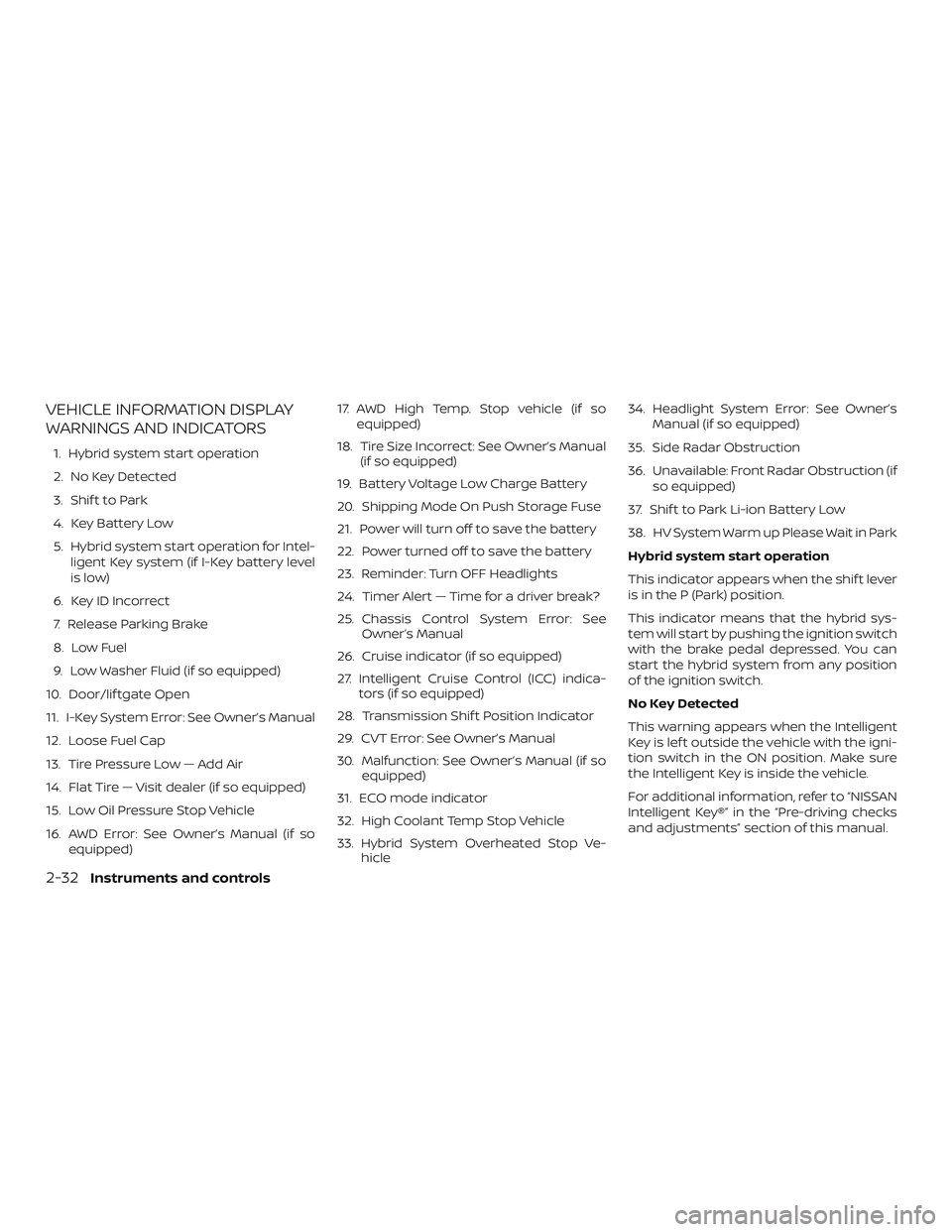
VEHICLE INFORMATION DISPLAY
WARNINGS AND INDICATORS
1. Hybrid system start operation
2. No Key Detected
3. Shif t to Park
4. Key Battery Low
5. Hybrid system start operation for Intel-ligent Key system (if I-Key battery level
is low)
6. Key ID Incorrect
7. Release Parking Brake
8. Low Fuel
9. Low Washer Fluid (if so equipped)
10. Door/lif tgate Open
11. I-Key System Error: See Owner’s Manual
12. Loose Fuel Cap
13. Tire Pressure Low — Add Air
14. Flat Tire — Visit dealer (if so equipped)
15. Low Oil Pressure Stop Vehicle
16. AWD Error: See Owner’s Manual (if so equipped) 17. AWD High Temp. Stop vehicle (if so
equipped)
18. Tire Size Incorrect: See Owner’s Manual (if so equipped)
19. Battery Voltage Low Charge Battery
20. Shipping Mode On Push Storage Fuse
21. Power will turn off to save the battery
22. Power turned off to save the battery
23. Reminder: Turn OFF Headlights
24. Timer Alert — Time for a driver break?
25. Chassis Control System Error: See Owner’s Manual
26. Cruise indicator (if so equipped)
27. Intelligent Cruise Control (ICC) indica- tors (if so equipped)
28. Transmission Shif t Position Indicator
29. CVT Error: See Owner’s Manual
30. Malfunction: See Owner’s Manual (if so equipped)
31. ECO mode indicator
32. High Coolant Temp Stop Vehicle
33. Hybrid System Overheated Stop Ve- hicle 34. Headlight System Error: See Owner’s
Manual (if so equipped)
35. Side Radar Obstruction
36. Unavailable: Front Radar Obstruction (if so equipped)
37. Shif t to Park Li-ion Battery Low
38. HV System Warm up Please Wait in Park
Hybrid system start operation
This indicator appears when the shif t lever
is in the P (Park) position.
This indicator means that the hybrid sys-
tem will start by pushing the ignition switch
with the brake pedal depressed. You can
start the hybrid system from any position
of the ignition switch.
No Key Detected
This warning appears when the Intelligent
Key is lef t outside the vehicle with the igni-
tion switch in the ON position. Make sure
the Intelligent Key is inside the vehicle.
For additional information, refer to “NISSAN
Intelligent Key®” in the “Pre-driving checks
and adjustments” section of this manual.
2-32Instruments and controls
Page 350 of 482
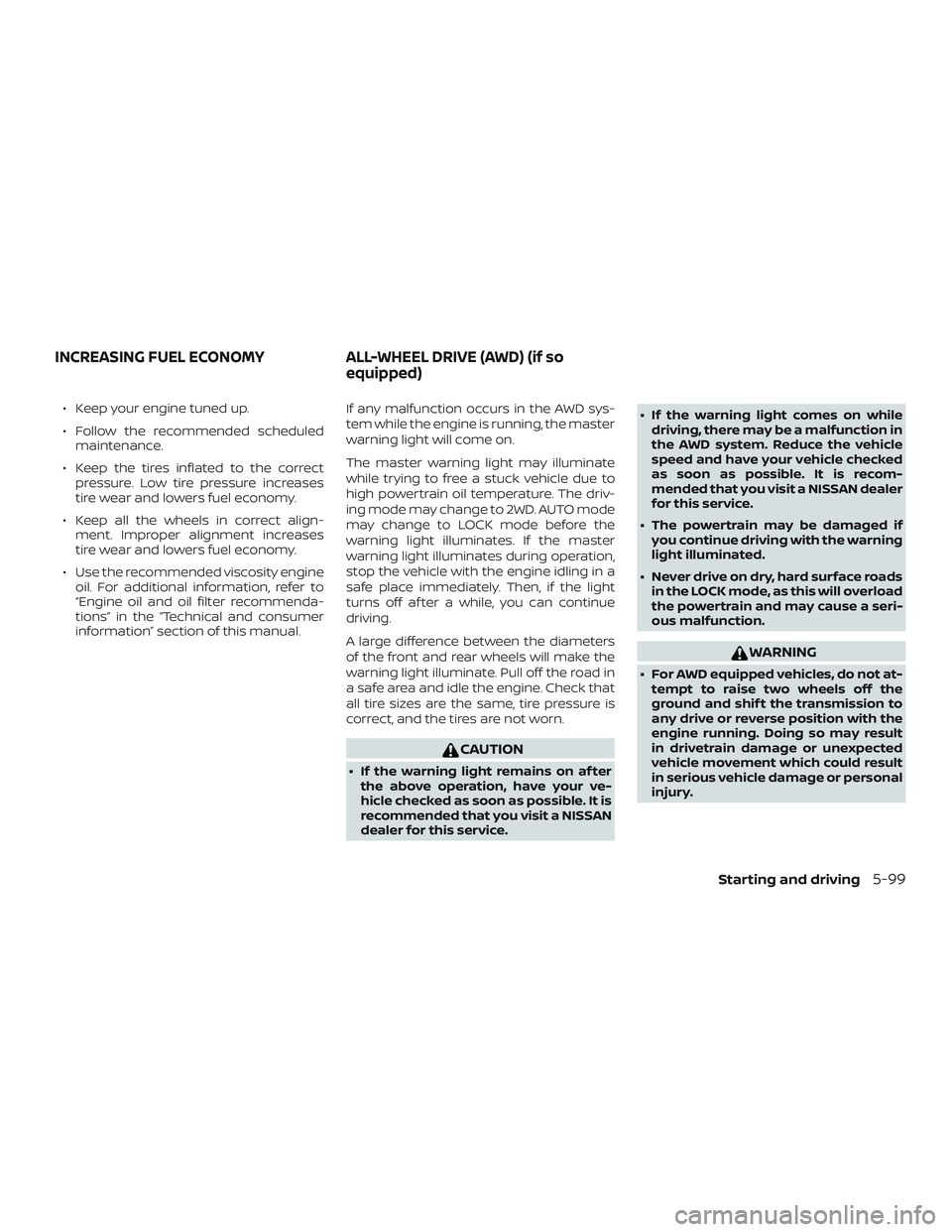
∙ Keep your engine tuned up.
∙ Follow the recommended scheduledmaintenance.
∙ Keep the tires inflated to the correct pressure. Low tire pressure increases
tire wear and lowers fuel economy.
∙ Keep all the wheels in correct align- ment. Improper alignment increases
tire wear and lowers fuel economy.
∙ Use the recommended viscosity engine oil. For additional information, refer to
“Engine oil and oil filter recommenda-
tions” in the “Technical and consumer
information” section of this manual. If any malfunction occurs in the AWD sys-
tem while the engine is running, the master
warning light will come on.
The master warning light may illuminate
while trying to free a stuck vehicle due to
high powertrain oil temperature. The driv-
ing mode may change to 2WD. AUTO mode
may change to LOCK mode before the
warning light illuminates. If the master
warning light illuminates during operation,
stop the vehicle with the engine idling in a
safe place immediately. Then, if the light
turns off af ter a while, you can continue
driving.
A large difference between the diameters
of the front and rear wheels will make the
warning light illuminate. Pull off the road in
a safe area and idle the engine. Check that
all tire sizes are the same, tire pressure is
correct, and the tires are not worn.
CAUTION
∙ If the warning light remains on af ter
the above operation, have your ve-
hicle checked as soon as possible. It is
recommended that you visit a NISSAN
dealer for this service. ∙ If the warning light comes on while
driving, there may be a malfunction in
the AWD system. Reduce the vehicle
speed and have your vehicle checked
as soon as possible. It is recom-
mended that you visit a NISSAN dealer
for this service.
∙ The powertrain may be damaged if you continue driving with the warning
light illuminated.
∙ Never drive on dry, hard surface roads in the LOCK mode, as this will overload
the powertrain and may cause a seri-
ous malfunction.
WARNING
∙ For AWD equipped vehicles, do not at-tempt to raise two wheels off the
ground and shif t the transmission to
any drive or reverse position with the
engine running. Doing so may result
in drivetrain damage or unexpected
vehicle movement which could result
in serious vehicle damage or personal
injury.
INCREASING FUEL ECONOMY ALL-WHEEL DRIVE (AWD) (if so
equipped)
Starting and driving5-99
Page 394 of 482
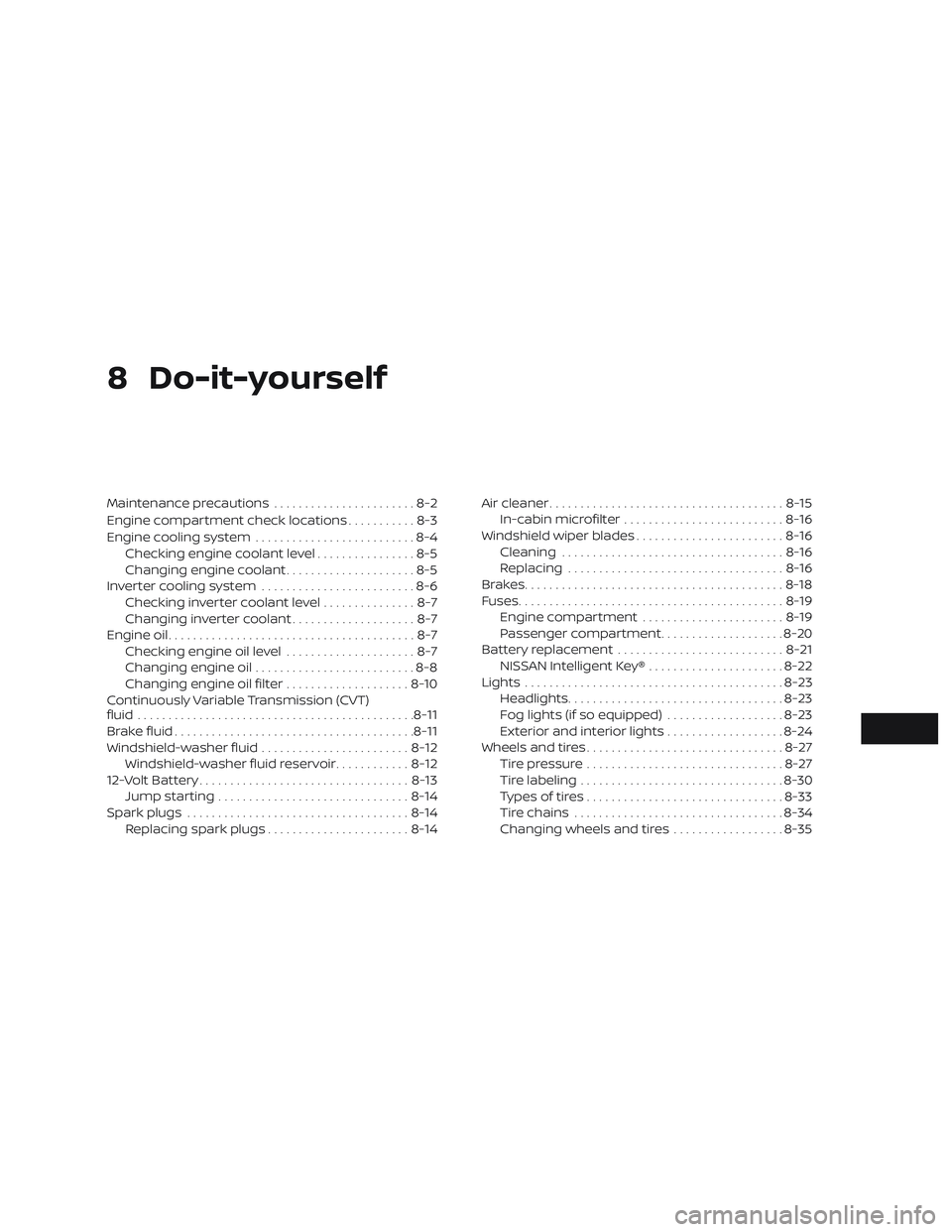
8 Do-it-yourself
Maintenance precautions.......................8-2
Engine compartment check locations ...........8-3
Engine cooling system ..........................8-4
Checking engine coolant level ................8-5
Changing engine coolant .....................8-5
Inverter cooling system .........................8-6
Checking inverter coolant level ...............8-7
Changing inverter coolant ....................8-7
Engine oil ........................................8-7
Checking engine oil level .....................8-7
Changing engine oil ..........................8-8
Changing engine oil filter ....................8-10
Continuously Variable Transmission (CVT)
fluid ............................................. 8-11
Brake fluid ....................................... 8-11
Windshield-washer fluid ........................8-12
Windshield-washer fluid reservoir ............8-12
12-VoltBattery.................................. 8-13
Jump starting ............................... 8-14
Spark plugs .................................... 8-14
Replacing spark plugs ....................... 8-14Air cleaner
...................................... 8-15
In-cabin microfilter .......................... 8-16
Windshield wiper blades ........................8-16
Cleaning .................................... 8-16
Replacing ................................... 8-16
Brakes.......................................... 8-18
Fuses ........................................... 8-19
Engine compartment ....................... 8-19
Passenger compartment ....................8-20
Battery replacement ........................... 8-21
NISSAN Intelligent Key® ......................8-22
Lights .......................................... 8-23
Headlights ................................... 8-23
Fog lights (if so equipped) ...................8-23
Exterior and interior lights ...................8-24
Wheels and tires ................................ 8-27
Tire pressure ................................ 8-27
Tire labeling ................................. 8-30
T
ypes of tires ................................ 8-33
Tire chains .................................. 8-34
Changing wheels and tires ..................8-35
Page 395 of 482
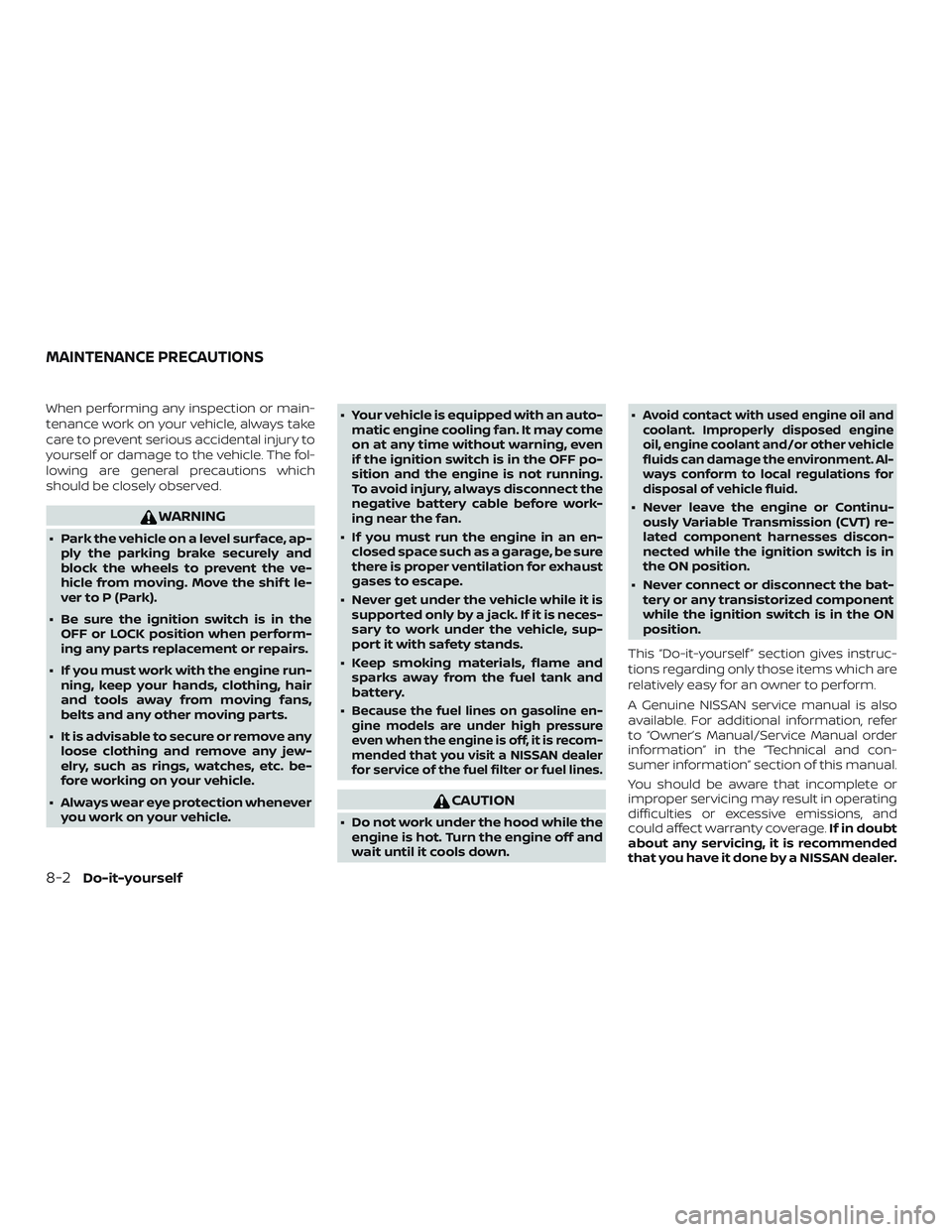
When performing any inspection or main-
tenance work on your vehicle, always take
care to prevent serious accidental injury to
yourself or damage to the vehicle. The fol-
lowing are general precautions which
should be closely observed.
WARNING
∙ Park the vehicle on a level surface, ap-ply the parking brake securely and
block the wheels to prevent the ve-
hicle from moving. Move the shif t le-
ver to P (Park).
∙ Be sure the ignition switch is in the OFF or LOCK position when perform-
ing any parts replacement or repairs.
∙ If you must work with the engine run- ning, keep your hands, clothing, hair
and tools away from moving fans,
belts and any other moving parts.
∙ It is advisable to secure or remove any loose clothing and remove any jew-
elry, such as rings, watches, etc. be-
fore working on your vehicle.
∙ Always wear eye protection whenever you work on your vehicle. ∙ Your vehicle is equipped with an auto-
matic engine cooling fan. It may come
on at any time without warning, even
if the ignition switch is in the OFF po-
sition and the engine is not running.
To avoid injury, always disconnect the
negative battery cable before work-
ing near the fan.
∙ If you must run the engine in an en- closed space such as a garage, be sure
there is proper ventilation for exhaust
gases to escape.
∙ Never get under the vehicle while it is supported only by a jack. If it is neces-
sary to work under the vehicle, sup-
port it with safety stands.
∙ Keep smoking materials, flame and sparks away from the fuel tank and
battery.
∙
Because the fuel lines on gasoline en-
gine models are under high pressure
even when the engine is off, it is recom-
mended that you visit a NISSAN dealer
for service of the fuel filter or fuel lines.
CAUTION
∙ Do not work under the hood while the engine is hot. Turn the engine off and
wait until it cools down. ∙
Avoid contact with used engine oil and
coolant. Improperly disposed engine
oil, engine coolant and/or other vehicle
fluids can damage the environment. Al-
ways conform to local regulations for
disposal of vehicle fluid.
∙ Never leave the engine or Continu- ously Variable Transmission (CVT) re-
lated component harnesses discon-
nected while the ignition switch is in
the ON position.
∙ Never connect or disconnect the bat- tery or any transistorized component
while the ignition switch is in the ON
position.
This “Do-it-yourself ” section gives instruc-
tions regarding only those items which are
relatively easy for an owner to perform.
A Genuine NISSAN service manual is also
available. For additional information, refer
to “Owner’s Manual/Service Manual order
information” in the “Technical and con-
sumer information” section of this manual.
You should be aware that incomplete or
improper servicing may result in operating
difficulties or excessive emissions, and
could affect warranty coverage. If in doubt
about any servicing, it is recommended
that you have it done by a NISSAN dealer.
MAINTENANCE PRECAUTIONS
8-2Do-it-yourself
Page 438 of 482
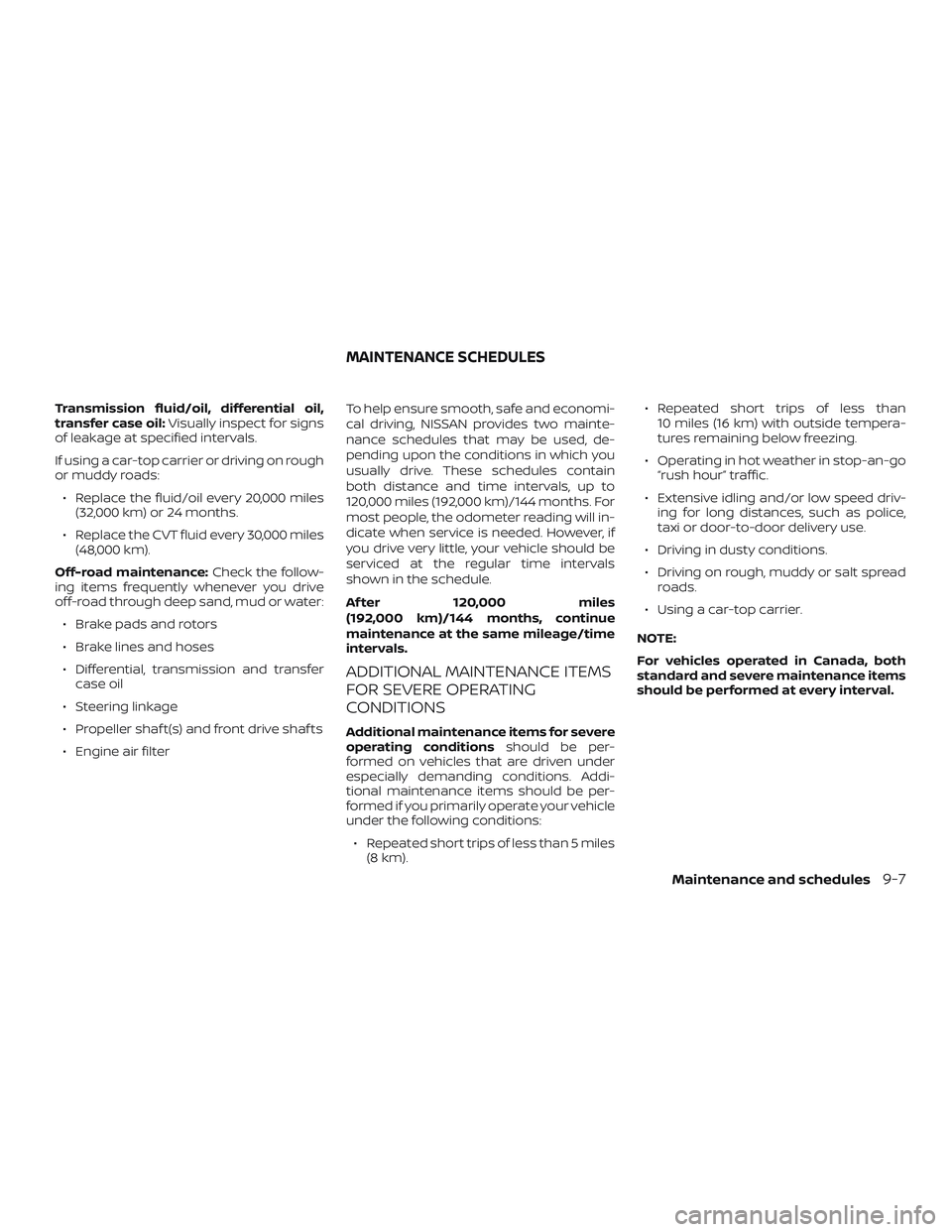
Transmission fluid/oil, differential oil,
transfer case oil:Visually inspect for signs
of leakage at specified intervals.
If using a car-top carrier or driving on rough
or muddy roads:
∙ Replace the fluid/oil every 20,000 miles (32,000 km) or 24 months.
∙ Replace the CVT fluid every 30,000 miles (48,000 km).
Off-road maintenance: Check the follow-
ing items frequently whenever you drive
off-road through deep sand, mud or water:
∙ Brake pads and rotors
∙ Brake lines and hoses
∙ Differential, transmission and transfer case oil
∙ Steering linkage
∙ Propeller shaf t(s) and front drive shaf ts
∙ Engine air filter To help ensure smooth, safe and economi-
cal driving, NISSAN provides two mainte-
nance schedules that may be used, de-
pending upon the conditions in which you
usually drive. These schedules contain
both distance and time intervals, up to
120,000 miles (192,000 km)/144 months. For
most people, the odometer reading will in-
dicate when service is needed. However, if
you drive very little, your vehicle should be
serviced at the regular time intervals
shown in the schedule.
Af ter
120,000 miles
(192,000 km)/144 months, continue
maintenance at the same mileage/time
intervals.
ADDITIONAL MAINTENANCE ITEMS
FOR SEVERE OPERATING
CONDITIONS
Additional maintenance items for severe
operating conditions should be per-
formed on vehicles that are driven under
especially demanding conditions. Addi-
tional maintenance items should be per-
formed if you primarily operate your vehicle
under the following conditions:
∙ Repeated short trips of less than 5 miles (8 km). ∙ Repeated short trips of less than
10 miles (16 km) with outside tempera-
tures remaining below freezing.
∙ Operating in hot weather in stop-an-go “rush hour” traffic.
∙ Extensive idling and/or low speed driv- ing for long distances, such as police,
taxi or door-to-door delivery use.
∙ Driving in dusty conditions.
∙ Driving on rough, muddy or salt spread roads.
∙ Using a car-top carrier.
NOTE:
For vehicles operated in Canada, both
standard and severe maintenance items
should be performed at every interval.
MAINTENANCE SCHEDULES
Maintenance and schedules9-7
Page 451 of 482
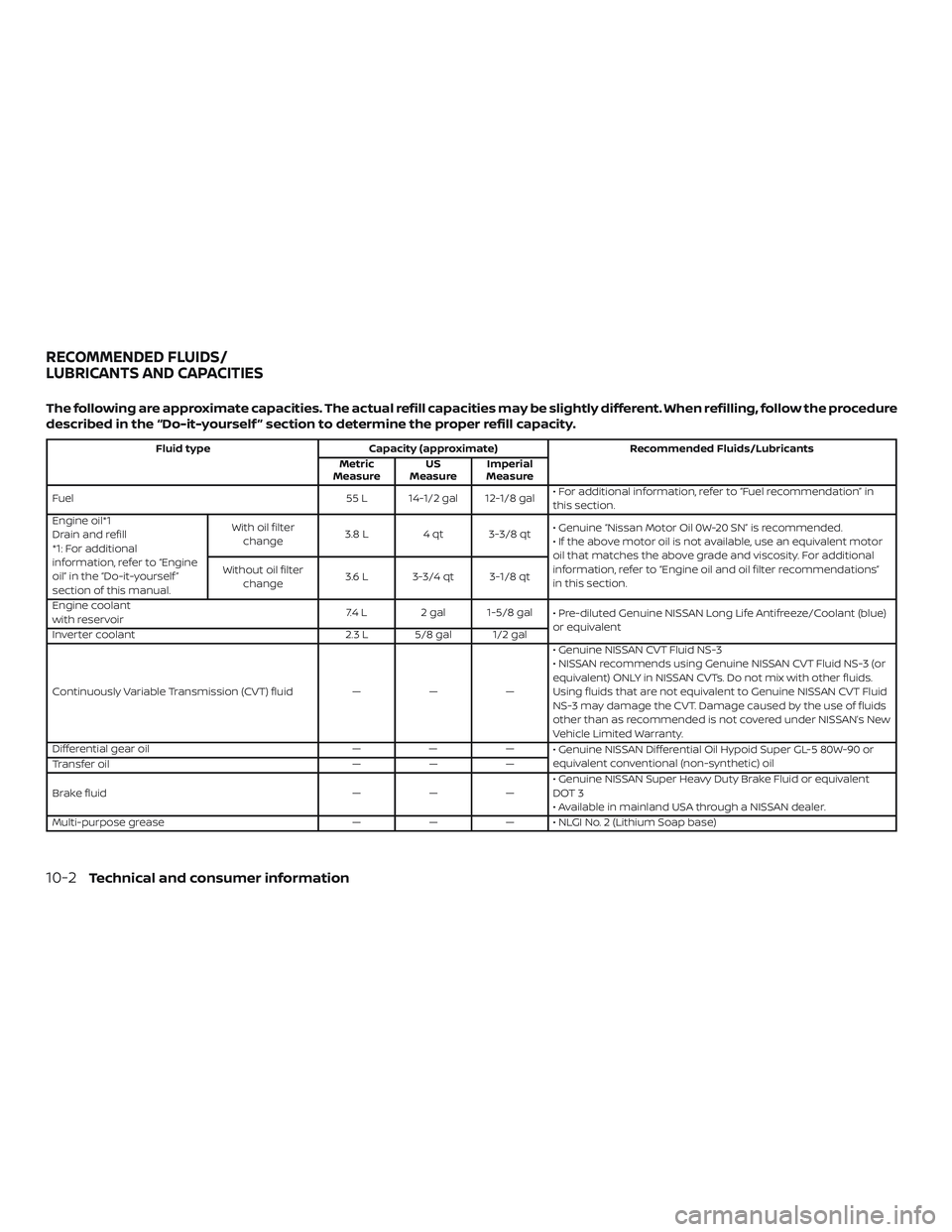
The following are approximate capacities. The actual refill capacities may be slightly different. When refilling, follow the procedure
described in the “Do-it-yourself ” section to determine the proper refill capacity.
Fluid typeCapacity (approximate) Recommended Fluids/Lubricants
Metric
Measure US
Measure Imperial
Measure
Fuel 55 L 14-1/2 gal 12-1/8 gal• For additional information, refer to “Fuel recommendation” in
this section.
Engine oil*1
Drain and refill
*1: For additional
information, refer to “Engine
oil” in the “Do-it-yourself ”
section of this manual. With oil filter
change 3.8 L
4 qt 3-3/8 qt • Genuine “Nissan Motor Oil 0W-20 SN” is recommended.
• If the above motor oil is not available, use an equivalent motor
oil that matches the above grade and viscosity. For additional
information, refer to “Engine oil and oil filter recommendations”
in this section.
Without oil filter
change 3.6 L 3-3/4 qt 3-1/8 qt
Engine coolant
with reservoir 7.4 L 2 gal 1-5/8 gal
• Pre-diluted Genuine NISSAN Long Life Antifreeze/Coolant (blue)
or equivalent
Inverter coolant 2.3 L 5/8 gal 1/2 gal
Continuously Variable Transmission (CVT) fluid ———• Genuine NISSAN CVT Fluid NS-3
• NISSAN recommends using Genuine NISSAN CVT Fluid NS-3 (or
equivalent) ONLY in NISSAN CVTs. Do not mix with other fluids.
Using fluids that are not equivalent to Genuine NISSAN CVT Fluid
NS-3 may damage the CVT. Damage caused by the use of fluids
other than as recommended is not covered under NISSAN’s New
Vehicle Limited Warranty.
Differential gear oil ———
• Genuine NISSAN Differential Oil Hypoid Super GL-5 80W-90 or
equivalent conventional (non-synthetic) oil
Transfer oil ———
Brake fluid ———• Genuine NISSAN Super Heavy Duty Brake Fluid or equivalent
DOT 3
• Available in mainland USA through a NISSAN dealer.
Multi-purpose grease ——— • NLGI No. 2 (Lithium Soap base)
RECOMMENDED FLUIDS/
LUBRICANTS AND CAPACITIES
10-2Technical and consumer information
Page 473 of 482
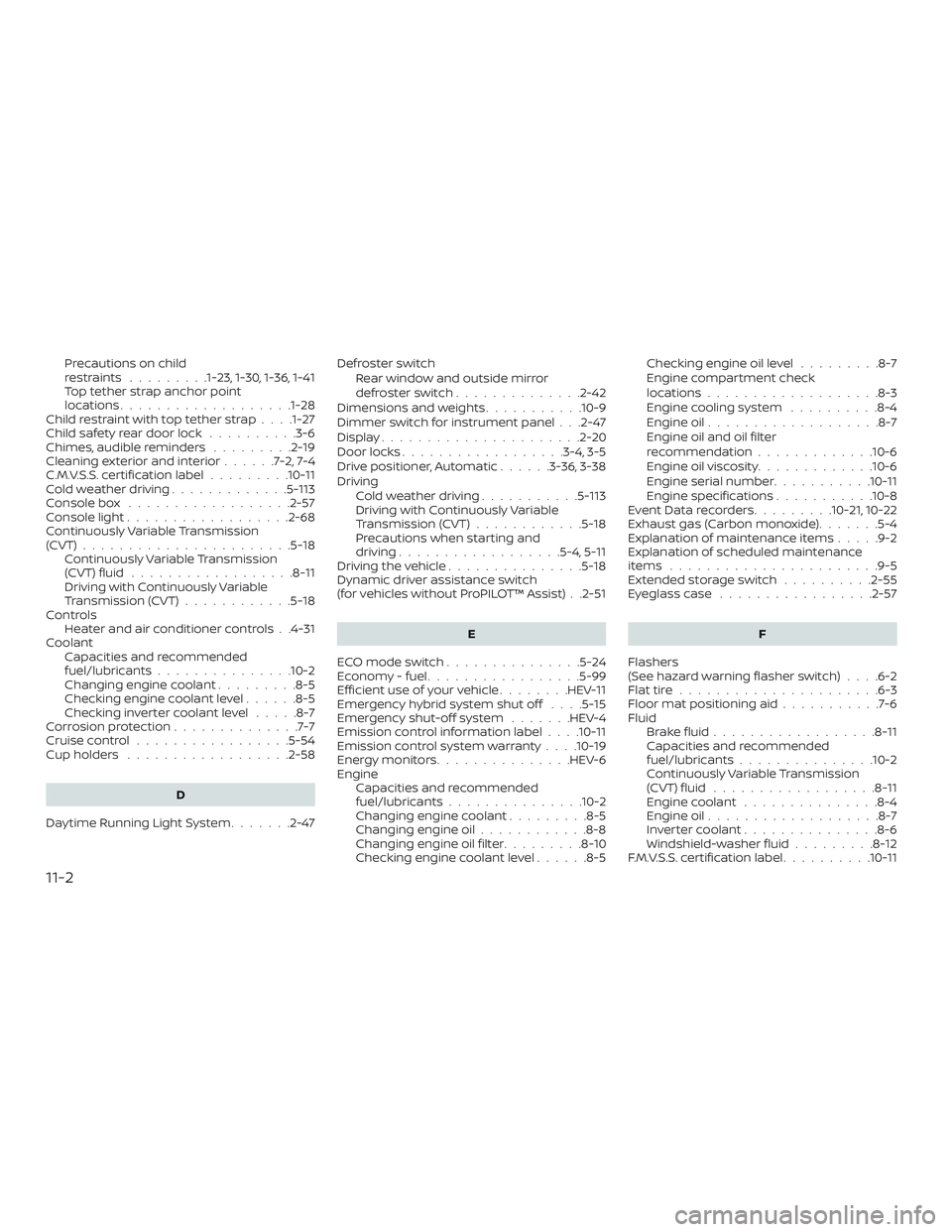
Precautions on child
restraints .........1-23, 1-30, 1-36, 1-41
Top tether strap anchor point
locations...................1-28
Child restraint with top tether strap . . . .1-27
Child safety rear door lock ..........3-6
Chimes, audible reminders .........2-19
Cleaningexteriorandinterior......7-2,7-4
C.M.V.S.S. certification label .........10-11
Coldweatherdriving.............5 -113
Console box ..................2-57
Console light ..................2-68
Continuously Variable Transmission
(CVT) .......................5-18
Continuously Variable Transmission
(CVT) fluid ..................8-11
Driving with Continuously Variable
Transmission (CVT) ............5-18
Controls Heater and air conditioner controls . .4-31
Coolant Capacities and recommended
fuel/lubricants...............10-2
Changing engine coolant .........8-5
Checking engine coolant level ......8-5
Checking inverter coolant level .....8-7
Corrosionprotection..............7-7
Cruisecontrol.................5-54
Cupholders ..................2-58
D
Daytime Running Light System .......2-47Defroster switch
Rear window and outside mirror
defrosterswitch..............2-42
Dimensions and weights ...........10-9
Dimmer switch for instrument panel . . .2-47
Display......................2-20
Door locks ..................3-4,3-5
Drive positioner, Automatic ......3-36,3-38
Driving Cold weather driving ...........5-113
Driving with Continuously Variable
Transmission (CVT) ............5-18
Precautions when starting and
driving..................5-4,5-11
Drivingthevehicle...............5-18
Dynamic driver assistance switch
(for vehicles without ProPILOT™ Assist) . .2-51
E
ECO mode switch ...............5-24
Economy - fuel .................5-99
Efficientuseofyourvehicle........HEV-11
Emergency hybrid system shut off ....5-15
Emergency shut-off system .......HEV-4
Emission control information label . . . .10-11
Emission control system warranty . . . .10-19
Energy monitors ...............HEV-6
Engine Capacities and recommended
fuel/lubricants...............10-2
Changing engine coolant .........8-5
Changing engine oil ............8-8
Changing engine oil filter .........8-10
Checking engine coolant level ......8-5Checking engine oil level
.........8-7
Engine compartment check
locations...................8-3
Engine cooling system ..........8-4
Engine oil ...................8-7
Engine oil and oil filter
recommendation .............10-6
Engine oil viscosity .............10-6
Engine serial number ...........10-11
Engine specifications ...........10-8
EventDatarecorders.........10-21,10-22
Exhaust gas (Carbon monoxide) .......5-4
Explanation of maintenance items .....9-2
Explanation of scheduled maintenance
items .......................9-5
Extended storage switch ..........2-55
Eyeglasscase .................2-57
F
Flashers
(Seehazardwarningflasherswitch)....6-2
Flattire......................6-3
Floormatpositioningaid...........7-6
Fluid Brakefluid..................8-11
Capacities and recommended
fuel/lubricants...............10-2
Continuously Variable Transmission
(CVT)
fluid..................8-11
Engine coolant ...............8-4
Engine oil ...................8-7
Invertercoolant...............8-6
Windshield-washer fluid .........8-12
F.M.V.S.S. certification label ..........10-11
11-2